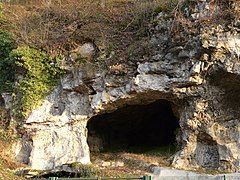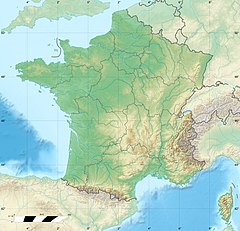Raymonden
| Abri de Raymonden | |

Raymonden entrance
|
|
| Location | near Chancelade |
|---|---|
| Region | département Dordogne, France |
| Coordinates | 45°12′25″N 0°40′25″E / 45.20694°N 0.67361°ECoordinates: 45°12′25″N 0°40′25″E / 45.20694°N 0.67361°E |
| Type | limestone |
| History | |
| Material | limestone |
| Periods | Upper Palaeolithic |
| Cultures | Magdalenian |
| Site notes | |
| Excavation dates | 1876 |
| Archaeologists | M. Hardy |
Raymonden is a prehistoric cave near Chancelade in the French département Dordogne. The cave was inhabited during the Upper Paleolithic and contained, besides lots of artefacts, a human skeleton.
The Raymonden cave occurs about one kilometer north of Chancelade on the left bank of the Beauronne river, a right-hand tributary of the Isle river. Just north of the cave the Beauronne starts to meander forming a first loop which is accompanied on its left side by a steep, rocky ledge. The rocks are composed of flat-lying Angoumian limestones, a local formation of the Turonian. The Angoumian used to be extensively quarried for building stones, and an enclosed resistant layer was mined for mill stones. The entry to the cave is hemmed in between two quarries, not far from the borough of les Grèzes. In front of the cave passes the D 939 from Périgueux to Brantôme, a major trunk road.
The prehistoric site was discovered in 1876 by M. Hardy, who also started the excavation work. He was followed in 1883 by two college teachers from Périgueux. During the construction of the railway line from Périgueux to Brantôme the deposits in front of the cave (including many stone and bone artefacts) were erroneously used as gravel for the track foundations and consequently spread out over nearly a kilometer ! After this vandalism with irreparable damage Hardy and M. Féaux started a systematic study of the site which lasted till 1888. Their endeavours were crowned by success because at the base of the archeological layer they found a tomb with human remains.
In 1927 L. Didon excavated a section in front of Raymonden cave, which was subjected to occasional flooding. After his death the work was continued by J. B. Bouyssonie from 1928 till 1929.
The damage done to the cave deposits by the railway workers seriously disturbed the original succession. Despite this considerable drawback in 1891 Hardy was still able to distinguish four ash layers within the 1.35 meter thick archeological succession; the individual ash layers were separated by thin sandy and clayey levels. The recovered artefacts were then brought to the Musée du Périgord in Périgueux but regrettably their exact position within the succession was never recorded. Even so certain characteristic finds clearly indicate the cultural epochs Magdalenian IV to Magdalenian VI.
...
Wikipedia


